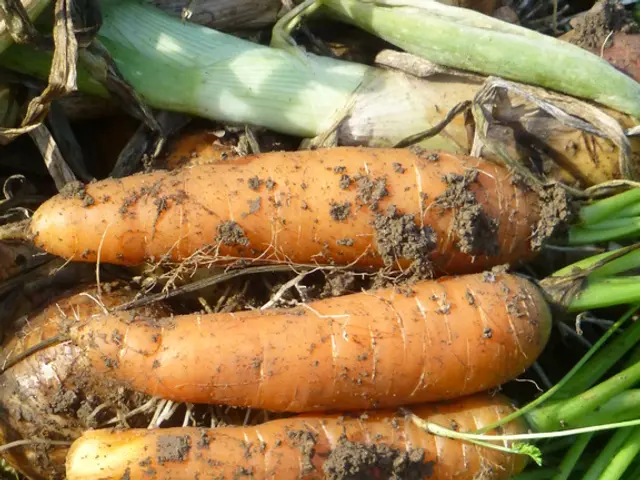Common Errors in Basic Vegetable Garden Management
Get your green thumbs ready! Here's a refresher on the common gardening mistakes and how to avoid them like a pro.
1. Putting Down Roots in the Wrong Spot
Whether you're growing veggies in raised beds, in-ground gardens, or pots, locating your garden wisely is key. Most veggies loves sun, lots of it. They need about 6 to 8 hours of sunlight to thrive. So, avoid the dark spots, and avoid areas that are waterlogged or poorly draining. If you're dealing with a less-than-ideal backyard, consider focusing on veggies that tolerate low light, like leafy greens and beets.
2. Dealing with Dreadful Soil
Poor soil is the nemesis of any gardener. Soil that's rocky, heavy with clay, overly sandy, or low in nutrients can make growing veggies a real hassle. Get to know your soil with a soil test. It'll reveal if you need to boost your soil with amendments like compost or pH adjusters. Once you got a handle on it, apply a 1 to 2-inch layer of compost, aged manure, or worm castings every spring or fall to keep your soil healthy.
Want to Create a Kick-Ass Organic Soil? Check Out These Tips!
3. Choosing the Wrong Plants
There's no rule that says you can't grow giant pumpkins or loofahs, but some veggies just aren't suitable for every garden. Make sure you choose plants that are the right size for your space and that can mature before fall frosts hit. Picking the right plants can save you from a world of hurt.
4. Overcrowding Your Space
It's tempting to cram as many plants as possible into your garden, but overcrowding can lead to stunted plants and problems with mildew. Make sure to give your plants some breathing room by following the recommended spacing. This is especially important in small gardens as overcrowding can lead to stunted growth and mold problems.
5. Sowing Seeds at the Wrong Time
Planting veggies too early or too late can lead to problems. Whether it's cold weather damaging seeds or not giving them enough time to mature before fall, planting at the right time is important. Pay close attention to the planting instructions on seed packets and consider starting slow-growing seeds indoors in spring.
6. Neglecting Hardening Off
Plants bought from a garden center are often already hardened off, but if you're starting your own seeds indoors, they need to be gradually introduced to outdoor conditions to avoid transplant shock and sunscald. Start by exposing the plants to brighter light and lower temperatures for a few hours a day, gradually increasing the time outdoors.
7. Drowning Your Veggies or Letting Them Wilt
Watering too much or too little is the number one reason for failed vegetable crops. Most veggies need about 1 inch of water per week. Water when the top inch of soil is dry. If possible, use drip irrigation or soaker hoses to keep the leaves dry and reduce the risk of fungal issues.
Check Out These Water-Saving Tips for Your Veggie Garden!
8. Sabotaging Your Plants with Too Much or Too Little Nutrition
Some plants need more fertilizer than others. Do your research to find out exactly how much your veggies need. A balanced liquid or granular fertilizer applied throughout the season is usually sufficient. But heavy feeders like melons may need more. Too much fertilizer, though, can burn the roots.
9. Allowing Weeds to Take Over
Weeds happen, but you can minimize their impact with careful garden maintenance. Use no-till gardening methods and cover your garden with a 1 to 3-inch layer of mulch to keep weeds at bay. If weeds do show up, use a hori-hori to dig them out.
10. Ignoring Pest Issues
While a few insects are welcome in the garden as they help with pollination, you'll want to keep an eye on pests to prevent them from taking over. Rotate crops, use companion plants to deter pests, and consider using row covers to protect vegetables like brassicas from cabbage worms.
Ready to Take on Garden Pests? These Methods can Help Protect Your Plants!
- For a successful 'edible gardening' venture, always select an appropriate spot that receives ample sunlight – about 6 to 8 hours daily – and has good drainage. Avoid areas prone to waterlogging or poor drainage.
- Understand your soil type with a test to identify if amendments like compost or pH adjusters are necessary for a nutrient-rich 'gardening' environment. Regularly apply a 1 to 2-inch layer of compost, aged manure, or worm castings in spring or fall for optimal soil health.
- Select plants suitable for your space, with the right size and maturity time to thrive, avoiding the hassle of awkwardly large plants or premature harvests.
- Ensure proper spacing between plants to prevent overcrowding, which may lead to stunted growth and mold problems, particularly in small gardens.
- Stick to the planting instructions on seed packets or timelines provided by gardening resources like 'bhg,' and take care not to sow seeds too early or too late to ensure healthy vegetable development.
- Adequately harden off indoor-started plants by gradually introducing them to outdoor conditions to prevent transplant shock and sunscald.
- Maintain the ideal watering schedule for your vegetables – about 1 inch of water per week – using drip irrigation or soaker hoses to keep leaves dry and reduce the risk of fungal issues.
- Provide your plants with the appropriate amount of fertilizer, considering their unique nutritional requirements. Excessive fertilizing may harm the roots, so follow instructions carefully.
- Minimize weed growth in your garden by adopting no-till methods, using mulch, and removing weeds carefully with a hori-hori.
- Constant monitoring of your garden for pests is crucial to maintain a healthy vegetable garden. Use techniques such as crop rotation, companion planting, and row covers to control pest infestations.








